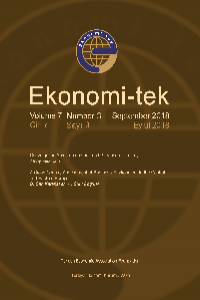Hızlı Büyüyen Firmalar ve Bölgesel Faktörler
Türkiye'nin bölgeleri arasında üretim yapısı ve dolayısıyla gelir itibariyle önemli farklar sergilediği pek çok çalışma tarafından ortaya koyulmuştur. Bu çalışma, bölgesel farklılıklara firma büyümesi ve büyüklük perspektifinden yaklaşmaktadır. Öncelikle, İBBS-II bölgeleri düzeyinde 2009-2013 dönemini kapsayan TÜİK Yıllık Sanayii ve Hizmet İstatistikleri mikro veri seti kullanılarak hızlı büyüme sergileyen firma dağılımlarının bölgesel olarak gösterdiği farklılıklar ortaya koyulmuştur. Daha sonra, firma büyümesi-büyüklük ilişkisi ve büyümenin bölgesel belirleyicileri araştırılmıştır. Literatürle uyumlu olarak büyüklük büyümeyi etkilemektedir. Bunun yanında, bölgesel faktörler de beklenildiği gibi firma büyümesi üzerinde etkilidir. Ayrıca, panel probit yöntemi ile tahmin edilen modele göre firmaların hızlı büyüme olasılığında bölgesel faktörlerin önemi ortaya çıkmaktadır.
Anahtar Kelimeler:
Firma Büyüklüğü, Büyüme, Bölgesel Endüstri Yoğunlaşması
High-growth Firms and Regional Factors
Production structure and the distribution of income between regions of Turkey has been revealed by many studies that demonstrate significant disparities. This study approaches regional disparities from the perspective of firm growth and size. First of all, regional differences in the distribution of firms that exhibited high growth were determined by using the TURKSTAT Annual Industry and Service Statistics micro data set covering the 2009-2013 period at NUTS-II level. Then, firm growth-size relationship and regional determinants of growth are investigated. In accordance with the literature, firm size does affect firm growth. In addition to that, regional factors are also influential on firm growth, as expected. According to the model estimated by the panel probit, the importance of regional factors in the high growth probability is also revealed.
Keywords:
Firm Size, Growth, Regional Industrial Concentration,
___
- Acs, Z. J., Armington, C. ve Zang, T. (2007), “The determinants of new-firm survival across regional economies: the role of human capital stock and knowledge spillover,” Papers in Regional Science, 86(3), 367–391.
- Audretsch, D. B. ve Dohse, D. (2007), “Location: a neglected determinant of firm growth,” Review of World Economy, 143(1), 33–45.
- Aydogan, Y. ve Donduran, M., (2019), “Concluding Gibrat’s law with Turkish firm data,” Physica A: Statistical Mechanics and its Applications, 533, 1220-66
- Barbosa, N. ve Eiriz, V. (2011), “Regional variation of firm size and growth: the Portuguese case,” Growth and Change, 42(2):125–158.
- Barbosa, N., Faria, A. P. ve Eiriz, V. (2014), “Industry- and firm-specific factors of innovation novelty”, Industrial and Corporate Change, 23(3), 865-902.
- Barringer, B.R., Jones, F.F. and Neubaum, D.D. (2005), A quantitative content analysis of the characteristics of rapid-growth firms and their founders, Journal of Business Venturing, 20(5): 663-687.
- Barrios, S., Bertinelli, L. ve Strobl, E. (2006), “Geographic concentration and establishment scale: An extension using panel data,” Journal of Regional Science, 46(4), 733-746.
- Bentzen, J., Madsen, E.S. ve Smith, V. (2012), “Do firms’ growth rates depend on firm size?” Small Business Economics, 39(4), 937-947.
- Birch, D. (1979), The job generation process. MIT program on neighbourhood and regional change, vol 302. MIT, Cambridge.
- Bogas, P. ve Barbosa, N. (2015), “High-growth firms: What is the impact of region-specific characteristics?” Rui Baptista, João Leitão (eds.) Entrepreneurship, Human Capital, and Regional Development: Labor Networks, 295-308, Switzerland: Springer.
- Coad, A. (2009), The growth of firms: A survey of theories and empirical evidence, Cheltenham: Edward Elgar.
- Coad, A. ve Hölzl, W. (2010), “Firm growth: empirical analysis,” Papers on economics and evolution, no.1002. Max Planck Institute of Economics, Germany.
- Faggio, G., Silva, O. ve Strange, W. C. (2016), “Heterogenous agglomeration”, Review of Economics and Statistics, vol. 99 iss. 1, doi: 10.1162/REST_a_00604.
- Falkenhall, B ve Junkka, F. (2009), “High-growth firms in Sweden 1997–2007 characteristics and development patterns,” The Swedish Agency for Growth Policy Analysis, Stockholm.
- Garcia, P.L. ve Puente, S. (2012), “What makes a high-growth firm? A dynamic probit analysis using Spanish firm-level data,” Small Business Economics, 39(4), 1029–1041.
- Guimarães, P., Figueiredo, O. ve Woodward, D. (2000), “Agglomeration and the location of foreign direct investment in Portugal,” Journal of Urban Economics, 47(1), 115–135.
- Hart, P. E. ve Prais, S. J. (1956), “The analysis of business concentration: A statistical approach,” Journal of the Royal Statistical Society, Series A (General), 119, 150-191.
- Henrekson, M. ve Johansson, D. (2010), “Gazelles as job creators: a survey and interpretation of the evidence,” Small Business Economics, 35(2), 227–244.
- Hözl, W. (2011), “Persistence, survival and growth. A closer look at 20 years of high-growth firms in Austria,” WIFO working paper, no. 403.
- Krugman, P. (1991), “Increasing returns and economic geography,” Journal of Political Economy, 99(3), 483–499.
- Lai, Y. G., Saridakis, G., Blackburn, R. ve Johnstone, S. (2016), “Are the HR responses of small firms different from large firms in times of recession?” Journal of Business Venturing, 31(1), 113-131.
- Mazzucato, M., ve Parris, S. (2015), “High-growth firms in changing competitive environments: The US pharmaceutical industry (1963 to 2002)”, Small Business Economics, 44(1), 145-170.
- Moreno, A.M. and Casillas, J.C. (2007), High-growth SMEs versus non- highgrowth SMEs: a discriminant analysis, Entrepreneurship & Regional Development, 19(1): 69-88.
- O’Regan, N., Ghobadian, A. ve Gallear, D. (2006), “In search of the drivers of high growth in manufacturing SMEs,” Technovation, 26(1), 30–41.
- Otto, A. ve Fornahl, D. (2009), “Long-term growth determinants of young businesses in Germany: The effects of regional concentration and specialization,” Romanian Journal of Regional Science, 3(1), 1-35.
- Simon, H. A. ve Bonini, C. P. (1958), “The size distribution of business firms,” American Economic Review, 48(4), 607-617.
- Singh, A. Ve Whittington, G. (1975), “The size and growth of firms,” Review of Economic Studies, 42(1), 15-26.
- Sutton, J. (1997), “Gibrat’s legacy,” Journal of Economic Literature, 35(1), 40-59.
- Teruel, M. ve Wit, G. (2011), “Determinants of high growth firms: why have some countries more high growth firms than others?” EIM working paper, no. H201107.
- ISSN: 2146-6173
- Yayın Aralığı: Yılda 3 Sayı
- Başlangıç: 2012
- Yayıncı: Türkiye Ekonomi Kurumu Vakfı
